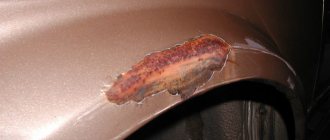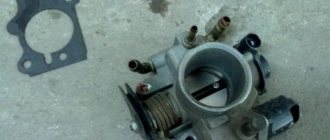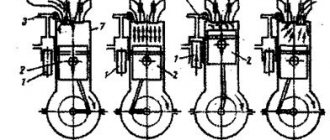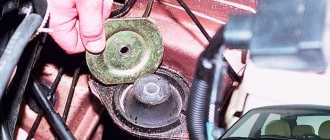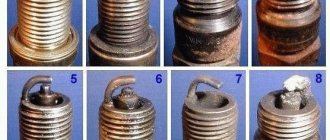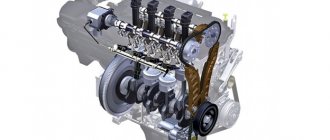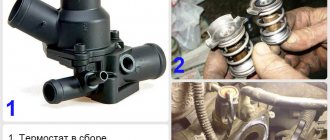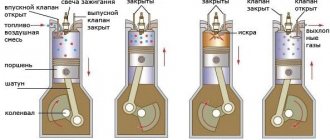How to flush the engine from carbon deposits without disassembling
The formation of carbon deposits in the combustion chamber of an engine is mainly associated with low-quality fuel.
As a result of incomplete combustion of this fuel, carbon deposits appear on the chamber walls and piston heads. When carbon deposits reach a certain mass, a large number of problems may arise in the operation of components and assemblies.
Let's look at the main signs of engine contamination, how to find out when it is necessary to remove carbon deposits, and how and how to clean the power unit.
I receive a lot of questions on the forum and in private messages about cleaning the combustion chamber. Let's look today at why this procedure is performed. Let's start with basic physics: There are two concepts such as compression and compression ratio.
What is compression?
Compression is the maximum pressure in the cylinder that occurs at the very end of the compression stroke. The magnitude of this pressure can be measured in various units, but the most common measurement is in atmospheres.
What is the compression ratio?
The engine compression ratio is the ratio of the working volume of the entire cylinder to the volume of the combustion chamber. The compression ratio directly affects engine power. The larger it is, the higher the pressure above the piston, and, accordingly, the higher the torque.
On a gasoline engine, depending on the specific task, the compression ratio can vary significantly, reaching values from 8 to 12. On diesel engines, due to their design features, the compression ratio is much higher and ranges from 14 to 18 units.
Note that compression is not a constant value, like the compression ratio of the engine, and changes downward as it wears out. But more on that a little later.
Knowing the compression ratio, you can easily determine what kind of compression should be on your engine. To do this, you need to multiply this parameter by 1.4 atmospheres. The result will, of course, be approximate, however, it can be relied upon as the optimal approximate pressure value.
Why are we looking at everything so deeply and in detail? In order to understand that each internal combustion engine at the factory is designed for a certain compression ratio. It is with this compression ratio that we will get maximum power from a given internal combustion engine, without losing the reliability of this internal combustion engine.
But over time, the compression in the internal combustion engine changes - it drops. This occurs due to wear of the cylinder-piston group, stuck rings, etc.
But sometimes this happens: the compression ratio, which is constant in an internal combustion engine, suddenly begins to increase! Why? The answer is simple: the volume of the combustion chamber has decreased! How can this happen? Yes, it’s elementary: carbon deposits are deposited on the valves and piston, which fills the volume of the combustion chamber, reducing the working volume of the chamber. Here are two photographs as an example that show how much carbon deposits there can be in the combustion chamber:
It would seem that this is good! Compression increases! It's actually bad!
On a car with a large amount of carbon deposits in the combustion chambers, very harsh fuel combustion and detonation occur. This is especially evident during cold starts of the internal combustion engine. Why is this happening?
The point is the characteristics of gasoline, which do not allow the compression ratio to be raised above a certain level without causing detonation. If we significantly increase the compression ratio, the power will increase, but we will have to refuel with higher octane fuel. And if we continue to drive with the usual fuel with detonation, then the engine will very quickly need repairs.
Toyota recommends cleaning combustion chambers on hybrid cars every 40-60 thousand km.
There are many methods for cleaning combustion chambers. Many of them are very barbaric (which harm the engine), others are extremely labor-intensive and require special equipment... Today I will tell you in detail about the methodology that we use in our “Hybrid Service”. It is not labor-intensive, does not require any special equipment and does not harm the car.
So, let's begin! What do we need for this procedure? 1. 1 bottle of special product 2. 1 assistant Let's take a closer look at the bottle with the product. We use Japanese professional auto chemicals from G-ZOX.
Why this one?
The first is the price-quality ratio.
We tested a lot of drugs from different companies and came to the conclusion that this is the best product.
The second is health safety.
This drug, although quite smelly (all procedures must be done on the street or by connecting a special hose to the exhaust pipe to remove exhaust gases), is not as dangerous as the well-known NOISE. SHUMA also cleans combustion chambers well, but has two significant drawbacks: high price and great harm to health. Of course, everyone can use what they like. We can only RECOMMEND.
Having warmed up the internal combustion engine of the car well, we park the car so that the exhaust pipe is “downwind”, i.e. so that the smoke from the muffler is blown away from the car by the wind.
We put the assistant behind the wheel and explain to him that his whole task is to press the gas pedal of the car to the floor, and at your command turn off the ignition.
Preparation takes less than a minute and involves opening the hood and removing the air filter cover.
After this, we give the command to the assistant “Press!”, and he presses the pedal to the floor. The speed of the hybrid car will rise slightly (up to 1400-1500 rpm).
And we ourselves begin to inject the product from the cylinder through a special extension tube (which comes complete with the cylinder) into the intake manifold (or in other words, onto the throttle valve). At the same time, it is very important not to hit the mass air flow sensor with the jet!
As liquid is injected from the cylinder into the engine, the latter will begin to lose speed (“choking”). As soon as you hear this, you stop injection and wait until the internal combustion engine reaches the required speed again. Inject again...
Continue this procedure until white smoke with a nasty smell comes out of the muffler (do not breathe it under any circumstances!)
The amount of smoke will directly depend on the degree of contamination of the combustion chambers.
Now, having seen a huge number of puffs of smoke, we press the cylinder nozzle “all the way” and press on it until the internal combustion engine stalls, i.e. will not “choke”. At the moment when the internal combustion engine stalls, the assistant must immediately turn off the ignition (otherwise after a couple of seconds the internal combustion engine will start again and you will have to “stoke” it again).
Now we note the time and wait exactly 10 minutes. (we chose this time experimentally).
After 10 minutes we start the internal combustion engine.
We ask the assistant to press the gas pedal to the floor again, and we ourselves continue, in small portions, injecting the remaining product from the cylinder into the intake manifold until it is completely finished.
As soon as the cylinder is empty, ask the assistant to release the gas pedal.
At this time, the process of charging the high-voltage battery will immediately begin and the internal combustion engine will operate continuously. (by pressing the gas pedal in parking mode, we forcibly turned off VVB charging).
Now we just have to be patient and wait until the white stinking smoke stops coming out of the exhaust pipe!
The procedure is over!
What else you should pay special attention to:
1. You cannot drive the car until white smoke stops coming out of the muffler.
2. If in the process, while you are waiting for the end of white smoke to come out of the car, the VVB charges and the car stalls, then we must help it - start the internal combustion engine for permanent operation.
How to do it: There are many ways. The simplest one is to switch the car (manually or with a scanner) to work in service mode. You can also turn on the air conditioning and the FULL button on those models that have it, or, for example, the heated windshield on a 20 Prius, etc. The main thing is to let the car run quietly until all the crap flies out through the exhaust pipe!
3. After the procedure, you need to use a scanner to remove all errors that may have appeared during the operation of cleaning the combustion chambers (or simply turn the ignition on and off on the car 5 times).
Good luck on the roads!
Gordeev Sergey Nikolaevich
(forum nickname - FERMER) Sverdlovsk region, Beloyarsky district, Kochnevskoye village, Sadovaya st., 33. +7 https://hybridservis.ru
Main signs of engine deposits
Carbon deposits and coke are the main products during the combustion of low-quality fuel. Under the influence of high temperature, when the amount of air is not enough to completely burn the fuel-air mixture, coke is formed. It settles in the form of dense deposits on the surface of the walls of the combustion chamber. Small particles separated from the coke form carbon deposits.
An important role in carbon formation is played by motor oil, which, if the tightness of the engine components (piston rings, valve seals) is insufficient, enters the combustion chamber. By burning with fuel, oil accelerates the process of deposit formation.
Carbon deposits in the engine lead to the following main malfunctions:
- problems with cold starting of the engine;
- when the engine is running, it smokes and runs unstable;
- exhaust gases mixed with burning;
- increased oil consumption;
- loss of power;
- increased fuel consumption;
- engine detonation and overheating at high speeds
Possible consequences of carbon deposits in the engine
It not only reduces operating efficiency, deteriorates overall performance, leads to high consumption of fuels and lubricants, but also increases the risk of serious engine damage and, as a result, expensive repairs. Main possible examples of such consequences:
- Formation of carbon deposits on the valves - the valve cannot close completely.
- deposits on the rings - rings become stuck.
- potassium ignition effect - uncontrolled ignition of the mixture from smoldering.
All of these examples can lead to critical situations. If the valves and rings are heavily coked, the valve does not close completely, the rings become stuck, and compression in the engine decreases. As a result, the engine starts poorly, malfunctions, valves burn out, and there is a need for expensive repairs.
Potassium ignition provokes uncontrolled ignition of the fuel-air mixture in the cylinders. Fuel ignites uncontrollably; the reason for this behavior is smoldering carbon deposits that ignite gasoline or diesel fuel. The engine overheats, causing increased wear on parts of the power unit, fuel system, and exhaust system.
To protect the engine from negative consequences, it is necessary to periodically flush it from accumulated deposits and toxins. After characteristic signs appear, you can clean the already clogged motor. Let's look at how to clean carbon deposits in the engine yourself.
Why is black carbon deposits on the piston dangerous?
The presence of black carbon deposits on the piston can cause serious damage to the internal combustion engine:
- detonation (sharp explosion of the fuel-air mixture in the combustion chamber);
- glow ignition (the fuel-air mixture ignites on its own due to overheated parts, without supplying a spark);
- dieseling (spontaneous combustion of the fuel-air mixture without a spark, due to high compression).
The appearance of detonation, glow ignition and dieseling significantly reduces the overhaul life of the engine. A sign of glow ignition and dieseling is that the car engine does not stall after switching off.
Carbon deposits and coke are the main ways to get rid of them from an engine
There are two main options that can be used to clean the motor, let's look at each of them:
- clean the power unit with any flushing agent;
- disassemble the engine and mechanically remove deposits
As for flushing oils and fuel additives, this cleaning will remove small deposits in the fuel system, lubrication system, combustion chamber and other places only if the contamination is insignificant. Otherwise, in case of heavy contamination, such additives will not wash away the deposits and the cleaning effect will not be achieved. Sometimes you can even make the situation worse and cause harm.
Many motorists are interested in the question of how to flush the engine from carbon deposits without disassembling it? Therefore, we will consider a method in which the unit does not need to be disassembled.
- We unscrew the spark plugs on gasoline cars, or potassium plugs on diesel cars.
- We pour a special “decarbonization” liquid into the cylinders through the spark plug wells.
- We wait several hours - the cleaner softens the deposits.
- We screw in the spark plugs and start the engine. The softened carbon burns out and is removed from the cylinders.
After this procedure, you cannot use the oil and oil filter remaining in the engine; they must be replaced. Getting into the engine crankcase, the washed composition saturates the oil and filter with abrasive particles that are aggressive towards the cylinders.
To achieve the maximum effect of engine cleanliness, it is necessary to use a mechanical cleaning method. Its principle is simple - the motor is disassembled and cleaned of carbon deposits and coke manually using an abrasive tool. Then it is washed with detergents with high surface activity. This method allows you to clean all hard-to-reach engine elements, including lubricant supply channels and other elements.
Mine at home
Let's consider folk art in the field of washing the space under the hood of a vehicle.
It is quite possible to achieve a decent result with your own hands, without using complex equipment and expensive specialized tools.
To work you will need to prepare:
- plastic bags;
- foil;
- dishwashing liquid;
- sponges;
- mittens;
- toothbrush;
- bristle brush;
- baking soda;
- towels;
- bucket;
- hose.
You can do without a hose. But provided that the water source is not far from the place of work.
Start with preparation. As part of the preparatory activities you will need:
- open the hood and securely fix it;
- turn off the ignition;
- remove the negative terminal from the battery;
- wait for the engine to cool down if it is hot;
- close the air intakes with bags;
- close the distributor, battery, fuse block;
- If possible, insulate wiring and contacts.
The essence of the preparation is to block as much as possible the possible access of water to those components that are not particularly friendly with moisture. This is what foil and bags are for.
Let's start cleaning
Having completed all the steps to prepare the car, you can proceed to the main stage.
At this stage you will need:
- prepare a solution based on warm water and detergent;
- try to avoid getting this composition on the paintwork;
- using regular warm water, moisten the contaminated areas;
- now, moistening the sponge in the solution, begin to remove dirt;
- if the sponge does not help or is not enough, use brushes.
Alternatively, you can use a solution of kerosene and water. It is more effective for heavily ingrained stains.
After removing all dirt, treat all surfaces again with soapy water. Let stand for 5-10 minutes. Now rinse the compartment with a hose under low pressure. Or you can simply rinse with water.
If some elements are not washed well, repeat the procedure for them again.
After rinsing off all the previously applied detergent, arm yourself with paper towels and begin to remove excess moisture. The better you dry the engine, the higher the likelihood of a successful outcome of the entire wash.
When most of the moisture has been removed, remove the bags and foil.
You may ask why they took soda. It's simple. Wipe the battery terminals with a solution of baking soda and plain warm water in a ratio of 1 to 1. This is an excellent remedy for combating oxidation. After all, batteries use acid. And the best acid antagonist is alkali. As you know, baking soda is an alkali.
Once drying is complete, start the engine for about 5 minutes. Let it idle, warm up, and the excess moisture that you didn’t reach will evaporate on its own. It wouldn’t hurt to apply an additional layer of polish or wax specifically for the engine compartment.
Advantages of engine cleaning without disassembly
Obviously, the main advantage is the absence of the need to disassemble the power unit. Mechanical disassembly is a complex and time-consuming process that requires an impressive amount of work. Carrying it out just for the sake of removing carbon deposits is impractical. This procedure is typical when performing major engine repairs.
It is worth noting that before performing the cleaning procedure, you should seek advice from professional mechanics. A completely cleaned engine is beyond the power of even very strong chemicals, and its incorrect use can cause damage.
The most common risk is blockage of the channels by particles separated from carbon deposits. Sometimes, in such a development of events, it is better not to touch the engine - this will allow it to be used for some more time. Otherwise, when you try to wash it, the likelihood of subsequent repairs is very high.
How can I prevent carbon deposits from accumulating in my engine?
The above allows us to draw a simple general conclusion: you need to take care of your car's engine. How? Everything is very simple. You need to visit the technical center regularly. And not only when it's time to change the engine oil. It is advisable to visit the service center more often and carry out computer diagnostics. You should consider your car's engine as a complete mechanism, without dividing it into areas, servicing each in turn . Thus, checking the engine should not be limited to changing the oil and filter, but should include a complete diagnostic of the engine, including updating the software.
In addition, the more often you connect your machine to your computer, the more likely it is that you will detect problems in time. After all, a mechanic cannot always understand in a timely manner that, for example, some ignition coil has started to work incorrectly. But by connecting diagnostic equipment, he can find out about this before the car begins to show signs of malfunction.
Also, for example, by connecting the car to a computer, you can even find out whether the thermostat opens too early or late. And as you know, a faulty thermostat can lead to engine overheating, etc.
– Excessive accumulation of carbon deposits can cause problems with rough running of the engine, and such symptoms include misfire, incorrect exhaust gas composition, and improper operation of the lambda probe (oxygen sensor(s) in the exhaust system). This can also lead to problems with the ignition system and even increase fuel consumption. The biggest problem with carbon deposits is the deposits that appear on the elements of the injection system, says Vladimir Drozdovsky.
If a driver or mechanic notices any of the symptoms or problems listed above, they should suspect excessive buildup of carbon deposits in the engine.
Where does the soot come from?
The formation of carbon deposits is caused by many factors and is typical for all types of internal combustion engines - gasoline and diesel, naturally aspirated and turbocharged, with indirect and direct fuel injection.
See also: Buying a used car with direct injection
Engine deposits occur as a result of non-ideal combustion of the air-fuel mixture. For example, in engines with direct injection of gasoline, one of the causes of carbon deposits is the method of fuel supply itself - gasoline in this case does not wash the valves, but goes directly into the combustion chamber . This causes deposits to build up on the valves and, therefore, restricts the access of oxygen to the combustion chamber over time, which in turn leads to improper combustion of the fuel mixture.
If you look at the problem more broadly, it is not difficult to discover other indirect causes of carbon deposits in car engines. They are due to the fact that in recent years, most car enthusiasts have changed the way they use their cars. Today, more and more people use a car as a bicycle, public transport or for a short walk/trip to the store.
– Most often, large deposits accumulate in the engines of vehicles operated in urban mode, over short distances. And it doesn’t matter what brand and model we are talking about. The way you use the car is important: low speed, low operating temperatures, using the car without warming up the engine - this is the main formula that guarantees the rapid appearance of carbon deposits in the engine, explains Profmotorservice expert Vladimir Drozdovsky.
Plus add to this the fact that many modern gasoline engines today are often turbocharged, meaning that a turbocharged car in city driving is most often used at low engine speeds. In the upper speed range, turbo engines are rarely used in city conditions today. But even naturally aspirated modern engines with direct gasoline injection also do not encourage owners to drive at high speeds. The fact is that today's naturally aspirated engines are good at generating high torque at low speeds . Accordingly, the car owner no longer needs to drive frequently at high speeds. This is a significant difference between turbine-free modern engines and engines of 20 years ago.
See also: Here's how to switch manual transmission for better fuel economy
Unfortunately, due to lower speeds, modern engines take longer to warm up (plus remember that many engines today are aluminum, which quickly lose their heating temperature, unlike older cast iron ones), and low speeds do not allow carbon deposits to be naturally removed from the engine. As a result, deposits begin to accumulate on various parts in the power unit.
In the past, up to 2000 rpm, it was impossible to drive even at a constant speed. Today, when accelerating, you don't need to exceed them. This results in a large accumulation of deposits in the engine.
Another reason for the formation of carbon deposits is improper oil change and untimely engine maintenance . For example, the main enemy of any internal combustion engine is the increase in engine oil change intervals. After all, it is known that the longer the engine oil is not changed, the more by-products are formed in it. Unfortunately, today many manufacturers have deliberately increased their oil change service intervals. For example, many automakers have increased oil change intervals from 10 thousand km to 15 thousand km (in Russia).
In their opinion, modern engine design, electronics and the quality of synthetic oils allow the use of motor oil for 15 thousand km without harm to the engine. Some manufacturers have gone even further, expanding the service interval to 20 thousand km. But look at the recommendations of manufacturers in Europe and you will be surprised. There, compared to Russia, service intervals for oil changes are increased even more - up to 25 thousand km and even 30 thousand km!
See also: Motor oil: what does its color mean?
But we have already told you why you don’t need to listen to the dealer and the factory, strictly following the recommendations for changing the oil. In most cases, you need to understand that the manufacturers' recommendations relate to general light operating conditions of the vehicle. If you use the car mainly in the city, then you can immediately safely reduce the recommended maximum mileage of the car before changing the oil by 20-30 percent. If you use a car for short distances with an underheated engine, do not hesitate to divide the manufacturer’s recommendations by two.
But butter is not so bad. Today, in difficult economic conditions, when the income of the population leaves much to be desired, and the cost of fuel is already approaching the cost of 1 liter of milk, many drivers try to save on the maintenance of their cars by visiting not only unauthorized unofficial technical services, but also not very professional craftsmen working in so-called garage car services. Yes, this allows car owners to save a lot of money on maintenance and save time. But there is one problem. In such cheap garage car services, many car mechanics do not have the ability to connect the vehicle to a computer to update the car's software and diagnose possible problems .
Did you know that the most common cause of excessive carbon deposits in an engine is unupdated engine control unit software? Because of this, the car engine may not work properly, resulting in improper combustion of the fuel mixture. And manufacturers often update the software for their cars.
Another direct cause of the accumulation of carbon deposits is improper engine timing, which is the responsibility of the timing belt/timing chain. Unfortunately, in gasoline engines, the belt and even the chain tend to stretch. This is a problem with many modern engines (a good example is the world's popular TSI/TFSI engines). If the tension of the chain or belt weakens, the gas distribution system becomes desynchronized, which in turn leads to improper combustion of the fuel mixture.
From this we conclude: everything that has an indirect or direct effect on the course of the combustion process is the cause of the accumulation of carbon deposits in the engine. This also applies to poor quality fuel or the operation of the ignition system (coils, spark plugs, etc.).
How to remove carbon deposits in an engine?
One of the easiest ways to remove carbon deposits is the so-called engine flush with a special composition. For this purpose, a special flushing agent is used, which is poured into the engine when you change the oil. You can flush the engine yourself. You can also order this service at the service center when you arrive for a standard oil change. However, in this case you will pay extra for it.
– One of the few invasive ways to remove accumulated carbon deposits without removing the engine head is what is called engine hydrogenation. However, you should not expect impressive results from this process. Hydrogenation is the introduction of a gas mixture into the engine, which increases the temperature of the exhaust gases. Thus, deposits turn into gases and are emitted along with exhaust gases, explains Vladimir Drozdovsky.
It should be remembered that in this way it is impossible to remove carbon deposits from the entire engine, but only from those areas through which gases flow - the combustion chamber, the exhaust system.
The only truly effective way to clean an engine is to disassemble it and clean all parts manually or mechanically, depending on the component. But such expensive cleaning is usually only worthwhile for engines that already have a lot of problems and cannot be cleaned any other way. In any case, such work will be very expensive, especially considering the volume of work.
No washing, no hydrogenation.
– Today there are already car owners who are interested in high-quality engine flushing. But quite recently this service was not in demand. Although, it is worth admitting, in the good old days, many people flushed the engines of their old cars with every oil change. But when modern vehicles appeared, washing was widely forgotten. However, car owners are gradually learning more and more that flushing or comprehensive cleaning of the engine from carbon deposits is extremely necessary. This is largely facilitated by car mechanics working in dealerships, telling drivers about the consequences of carbon deposits in the engine, says Vladimir Drozdovsky.
However, the best precaution is, of course, routine engine maintenance. Instead of using expensive flushes to remove carbon deposits, you can kind of flush out your car's engine by simply changing the oil two or three times more often, at shorter intervals, such as every 5,000 to 7,000 km. It is also worth remembering to change engine oil more frequently in engines operated over short distances. In order not to rack your brains about what to do with carbon deposits, it is better to prevent the accumulation of carbon deposits. To do this, not only change the oil more often, but also drive the car more dynamically after the engine warms up, using higher speeds.
Engine carbon deposits - cleaning carbon deposits and oil deposits
Soot in the engine, like fatty deposits in oil, is an inevitable process. This applies to gasoline and diesel power units. The formation of soot and coke is associated with the use of low-quality fuel and occurs under conditions of high t0 combustion of the fuel and air mixture in a closed chamber. To describe carbon deposits in a few words, we can say that this is a layer of unburned deposits that settles on the walls of the engine combustion chamber.
Long-term operation of a vehicle leads to the progression of coking and engine soot. At a certain point, carbon formation can provoke malfunctions and “technical diseases” of diesel units and gasoline internal combustion engines.
In the article you will learn about the signs of engine contamination and the consequences. Issues of effectively combating this phenomenon, signs of carbon deposits in the engine and the possible consequences of coking of power plants are raised. Traditionally, at the end of the article, we will summarize.
Signs of engine contamination
Before we figure out how to clean the engine from carbon deposits, let's determine what are the main signs of unstable operation of the power plant and the first symptoms of the disease.
The carbon formation process is accelerated by engine oil, which, due to poor sealing of power unit parts, penetrates into the combustion chamber. The oil burns along with the fuel, accelerating the deposit process.
Malfunctions that may occur as a result of carbon deposits:
- Often, these are problems associated with starting the power plant “cold”.
- When it smokes and works unstably.
- There are problems with gas exhaust mixed with burning.
- Oil consumption often increases.
- Engine power is lost.
- There is an increase in fuel consumption by 10-15%.
- Detonation occurs, the engine quickly heats up and overheats, operating at high speeds.
Having become familiar with the signs of contamination in the engine, you need to dwell on the consequences of carbon deposits.
other methods
There are other ways to clean carbon deposits from valves.
- increased load on the engine. Perhaps not all car enthusiasts know that the valves on the engine have a self-cleaning property. Carbon deposits are formed not least due to the fact that the car is operated in urban conditions, at low speeds, with low engine speeds and long periods of idling. Therefore, periodically you need to give the engine full load. In this case, the carbon deposits on the valves burn out;
- cleaning with an alcohol-gasoline-oil mixture. The proportion of the mixture components should be 50:45:5. With this mixture, you need to start the engine and let it run for about 2 minutes at high speeds. Nagar must go.
Source
What can happen if there is carbon deposits in the engine
It is important that deposits have a detrimental effect on overall stable operation, which ultimately leads to excessive consumption of fuel and technical fluids. It also increases the risk of engine failure: as a result, the likelihood of serious engine repair increases significantly. Let's move on to specific examples of negative consequences. It could be:
- carbon deposits on valves that open only partially;
- deposited carbon on the piston rings leads to their formation;
- from the smoldering process of carbon particles, an uncontrolled ignition of the combustible mixture can occur.
The situations that are described above can ultimately lead to a critical situation.
Due to severe coking, the valve cannot close completely. Which leads to the occurrence of rings. At the same time, compression in the engine decreases. Naturally, it doesn’t start well and malfunctions occur.
As a result, the valves burn out, which over time leads to the need for repair work, which is not cheap. Unauthorized combustion of the fuel-air mixture provokes potassium ignition due to smoldering carbon deposits.
Diesel and/or gasoline installations quickly overheat. This, in turn, leads to premature wear of engine parts and adversely affects the fuel and exhaust systems.
You can extend the service life of engine parts by washing slags and deposits. If the first signs of this phenomenon appear, you need to clean the clogged engine from carbon deposits. Read about it below.
Reasons for the formation of carbon deposits on valves
In addition to the design features of certain types of engines, there are also objective reasons why carbon deposits form on the valves of various engines. So, these include:
- Poor quality fuel . Unfortunately, many brands of domestic fuel (both gasoline and diesel) contain a large amount of harmful impurities (sulfur, lead and others). When the air-fuel mixture burns, some of these substances transform into a resinous state, and are deposited in this form on the surface of the timing system parts, in particular on the valves. In the case when you refuel with a large number of different additives, including ferocene or other iron oxide, which is added to reduce detonation, the carbon deposits on the valves will not be black, but red .
- Oil getting on the valves . Most often, such a malfunction is observed due to the fact that the valve stem seals do not cope with their function. Because of this, engine oil falls down, and then settles and subsequently burns on the valve body. This is a common reason why black carbon deposits appear on valves .
- Operation of the EGR system . This system is designed for afterburning exhaust gases and is used on many modern cars. Without going into details of its operation, it is only worth mentioning that the system returns a certain amount of exhaust gases, which contain carbon deposits, that is, tar deposits, soot, and so on, to the intake manifold. All this debris can settle on the walls, as well as on the timing valve plate. Moreover, this does not depend on the type of engine, so you need to understand that cars equipped with a USR system are more susceptible to the formation of carbon deposits on the valves.
- Time component . Any internal combustion engine is designed in such a way that various types of deposits form on its individual parts (not just valves) over time. And the greater the mileage, the greater the likelihood of the formation of such deposits. The differences in the predisposition to this consist only in the design features of certain engines.
In general, it is worth noting that most car enthusiasts encounter the appearance of carbon deposits on valves, especially those who use the car regularly and drive it long distances. At the initial stage, this does not cause major problems for both the driver and the engine. However, it is important to diagnose the problem in time and take appropriate action to eliminate it.
About the main ways to get rid of coke and deposits
In practice, you can get rid of the pollution problem:
- By completely disassembling the engine and removing carbon deposits mechanically, using abrasive tools.
- Clean the motor using special cleaning products.
However, flushing may not be as effective as desired and will only partially solve the problem. And disassembling the power plant is a troublesome and responsible task. To be fair, it must be said that disassembling the engine allows you to completely eliminate carbon deposits.
But, there are a number of other ways to clean deposits from an internal combustion engine without resorting to drastic methods, one of which can be considered a complete disassembly of the internal combustion engine. We are talking about removing carbon deposits without disassembling the engine.
The procedure for cleaning the engine from carbon deposits
First of all, you need to unscrew the spark plugs:
On cars running on gasoline, these are spark plugs.
- Through the spark plug wells, you need to pour “decarbonization” into the cylinders - this is a special liquid.
- A pause is necessary for the special liquid to do its job: soften the deposits. This will take approximately 2-3 hours.
- Next, unscrew the spark plugs and start the engine. During its operation, deposits will burn out and be removed from the engine cylinders.
- The procedure involves at the final stage the necessary replacement of the oil in the power plant and the oil filter.
A signal of a clogged air filter can be carbon deposits on black engine spark plugs. Clogged spark plugs can be caused by stuck piston rings. There are other methods of removing carbon deposits that have been proven in practice. We are talking about a multicomponent mixture based on acetone. To prepare the mixture you will need:
- 2 parts acetone, which can be replaced with a solvent.
- One part kerosene.
- One part motor oil.
And further
Flushing the engine with diesel fuel before the next change of technical fluid is an old and effective way to get rid of scale and coke, and also helps to rejuvenate the entire oil system. This is a simple, affordable and safe way to get rid of deposits and scale.
What else can you do to flush the inside of the engine? You can use a syringe to insert the needle of the injection system into the rubber tube passing between the vacuum regulator and the carburetor. Place one end into a container of water, which, due to vacuum, enters the carburetor and enters the engine cylinders with the air-fuel mixture. It is recommended to carry out the procedure on a working power plant. The escaping steam softens deposits and promotes their release. The process takes no more than 10 minutes.
A fuel additive can be used to remove deposits. This method solves the problem, the effect really exists. The most popular automotive chemicals are products of French manufacturers. Fuel additives have high cleaning power and cope with dirt. This method works on diesel units and gasoline units.
When talking about car maintenance, when replacing the filter, it is important to use oils recommended by the manufacturer. Pay attention to the synthetic all-season Total Oil made in France. It reduces friction of engine parts and allows you to easily start the engine at t0 up to – 350C.
A product produced in France, Total oil ensures easy operation of the engine and protects it from dirt. Total oil can be mixed with other standard motor oils.
How to properly clean a car engine
To obtain the expected result, it is necessary to clean the motor surface in the following sequence:
- Before starting work, it is necessary that the unit has cooled down to operating temperatures. Neglecting this requirement may cause deformation of the heated cylinder head when using sufficiently cold water.
- It is removed from the battery using a key. On vehicles with a hybrid powertrain, the specific location of the battery must be taken into account.
- After this, all elements located in the engine compartment (air intake, various sensors) should be protected from moisture. To do this, you need to use polyethylene as well as foil. If such work is done poorly or not done at all, then there is a guaranteed entry of water into the air duct. This will lead to quite serious damage to the internal combustion engine.
- The detergent is applied evenly over the entire surface of the car.
- The process of washing a car engine begins with slightly wetting the surface with warm water. After this, using a sponge or thick cloth, begin to wipe the contaminated surfaces. If some places are easy to reach, then it is advisable to use a brush or brush.
- It is not always possible to immediately clean the engine from oil and dirt using improvised means. If there are old oil stains on the engine body, then to remove them you need to use an ordinary toothbrush. After all, if it was not possible to immediately remove the oil stain, you need to use a more radical remedy. We are talking about using kerosene, but only for cleaning metal parts. After all, it is well known that using this substance on plastic and painted surfaces is extremely risky.
- The final stage of cleaning the car engine is rinsing it. During the rinsing process, it is important to prevent water from entering the locations of various electrical devices and sensors. It is very risky to wash away cleaning solution using a high pressure hose.
- After completing all the work, you need to make sure that the expected result was obtained and there is no need to re-clean the internal combustion engine.
